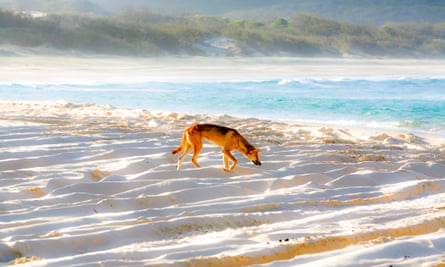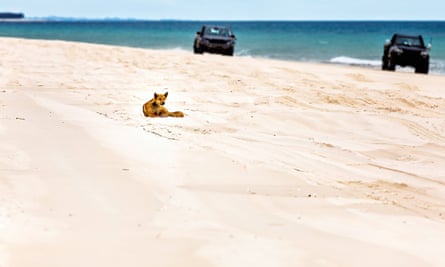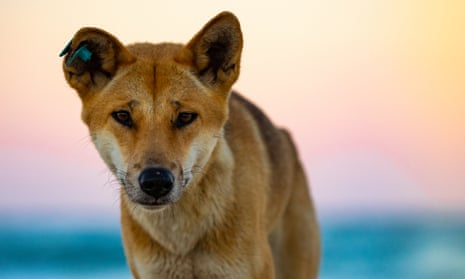Before they put down one of the wongari of K’gari they held a smoking ceremony. The execution is considered sorry business.
That’s because they are so significant in Aboriginal culture that the animals, also known as dingoes, are considered part of the family.
Darren Blake, fire coordinator at the Butchulla Aboriginal Corporation, has been involved in the humane destruction of a few animals in more than a decade as a K’gari ranger. He says it is a solemn occasion.
“We only do a smoking ceremony when it’s human intervention,” Blake said
“So when he or she goes up Sky Country … we smoke them to send their spirit up [and] to feel more relaxed and not angry.
“Because if we don’t do it they’ll be still wandering around in their spirit form and probably enter another wongari.”
Blake said they often even talk to the animal to prepare them for where they are going and to let them know it’s not their fault.
“They’re in our songlines and our storylines. They’re our totem as well. They’re very important to the Butchulla people.”
Tuesday’s ceremony was the fourth time in six months that the authorities killed one of the wongari of K’gari – also known as Fraser Island, about six hours north of Brisbane. All four had attacked people – tourists to one of Queensland’s most popular natural getaways.
The 200 or so wongari living on K’gari are among the most genetically pure dingoes in the world and every player in the management of the island wants to avoid destroying them.
Between 2020 and 2023 there were no animals put down at all, after the implementation of a new safety and management strategy by the state government.
But despite the safety crackdown, K’gari dingo attacks continue to be frequent. Environmental groups and the local Aboriginal corporation say it’s time for a new approach: a cap on people.

Peter Shooter, past president of the Fraser Island Defenders Organisation and a member of the K’gari world heritage advisory committee, said the death of even a handful of dingoes would have an effect on the shallow gene pool on the isolated island.
He said a genetic study by Southern Cross and Johannesburg universities revealed a lack of genetic diversity was “a potential risk for the population”.
“There is no immediate risk. But in the long term it is always a risk when you get populations down to the sizes the wongari on K’gari are.”
Are people the problem?
A spokesperson for Queensland’s environment department said the latest dingo to be destroyed had attacked two children and a man in three separate incidents, all in the Hook Point barge landing area, one of the busiest spots on the island.
They said euthanasia was a last resort, but “due to the escalation of the animal’s behaviour” the decision was made to euthanise the dingo. The Butchulla Aboriginal Corporation, the island’s native title holders, do not support euthanasia.
It’s not a new story. According to the department, there have been six dingo-related incidents on K’gari since 10 December, half of them involving children.
But it is people who are perceived as the real menace on K’gari by those who care for the land.
Rangers have already issued two fines in 2024 for leaving food out for dingoes. This is an offence because feeding is among the leading causes of “habituation”, which is the process by which an animal, even a naturally shy one like a wongari, becomes comfortable being around people.
Feeding is a particular problem because the animals learn to associate humans with an easy meal rather than as a threat. The dingoes have no natural predators, so people are the major risk to their life, Shooter says.
The solution: keeping people away from animals.
The government has tried everything: fencing human areas, signs warning of the fatal consequences of habituation for both human and animal, stepped-up patrols and more.
But Shooter says he’s seen a steady deterioration in people’s behaviour after the Covid period.
Tour groups tend to be well behaved but independent travellers sometimes outright ignore the rules, he says.
“Getting selfies, getting as close as possible,” he says. “They are cute animals, the little fellas particularly, they’re gorgeous. It is kind of human nature to want to get as close as possible to them and cuddle them because that’s what we do with our pets.
“These things are not pets. You wouldn’t you wouldn’t want to cuddle a lion cub … not out in their natural range.”

Shooter and the Butchulla Aboriginal Corporation are among many groups who believe it’s time to strengthen restrictions on tourists.
That might mean a process of banning the worst-behaved individuals from the island, or simple population caps at peak periods, such as those on Lord Howe Island, Antarctica and Machu Picchu.
John Green, a project coordinator at the Aboriginal corporation, has also worked as a ranger on K’gari for more than a decade.
“Capping the numbers for the peak periods would be an idea, because then the resources required to educate and have these opportunities happen is minimised,” he says.
“The sheer numbers do make it harder to be everywhere.”
He says such a cap could be balanced by more visitors outside the peak periods, with tourists spread over the quieter months rather than concentrated during the school holidays.
“That’s where these wongaris don’t get a chance … purely from the sheer numbers in those peak periods.”
Shooter points out that the idea may not be popular among everyone.
The Fraser Coast region gets more than half a million tourists a year, almost all domestic and many of them bound for K’gari. It’s a large and important industry.
But Shooters says as a result of the number of visitors the island’s “social fabric has changed”.
“We have caused it to change,” Shooter says. “It’s most unfair to think, well, the response to that is for, us who caused the change, to decide we will just kill the animals. That’s totally unacceptable.”
The immediate solution is more money.
In a statement, the department said it was investing an additional $2m this year plus $3m annually to expand safety messaging further and to support 13 new positions dedicated to dingo conservation and management.
The Butchulla Aboriginal Corporation is hoping to hire as many as four wongari rangers to deal solely with the animals, adding to seven or eight existing rangers.
Green says their role would be as much about managing people as the environment – keeping an eye on both groups, which is easier if there are fewer people.
“Our purpose would be to try to focus on the ones that are heading down that road [of habituation] and give them a chance to stay away from the visitors,” he says.
Shooter says it is humans who are the problem – even though animals pay the ultimate price. He says inevitably there will be more smoking ceremonies in the future as more wongari are euthanised.
“It’s not going to go away on its own. It will only go away by a change in human behaviour.”
with additional reporting by Australian Associated Press

Comments (…)
Sign in or create your Guardian account to join the discussion